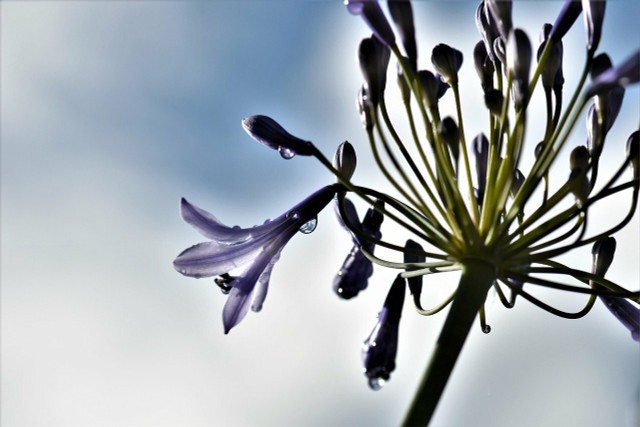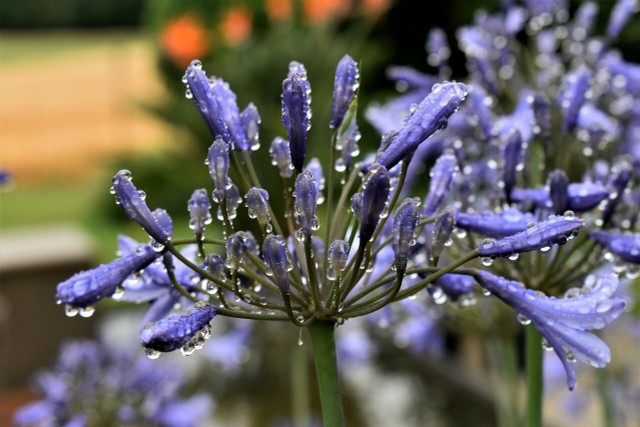
If you want to overwinter Agapanthus, you should follow some tips. Only then will the lily bloom for several years in pots and beds. Here you can find out how Agapanthus can safely survive the winter.
Agapanthus decorates the garden or balcony with white and purple flower balls. If you want to overwinter Agapanthus, it is important to protect the plant from frost and snow with timely measures. Start before the first frost sets in. This is the only way to ensure that your Agapanthus will be in bloom again the following year.
Originally from South Africa, the decorative lily is not adapted to the cold season in northern latitudes. However, there are frost-tolerant varieties. Therefore, it is important to consider the species-specific needs of your Agapanthus when caring for and overwintering it.
For more general tips, read our post on overwintering plants.
Contents
Agapanthus varieties
Before you can overwinter agapanthus, you should find out whether or not your plant is hardy.
Agapanthus belongs to the perennials and is especially popular as a container plant. A distinction is made between evergreen and deciduous species.
The evergreen species retain their foliage even in winter. They originate from mild climates and are therefore not hardy. Evergreen agapanthi therefore always overwinter in a winter quarters.
It is different with deciduous species. These agapanthi are also accustomed to cooler temperatures in their exotic home and have a better frost tolerance. They lose their leaves in the fall and, with proper care, can even be planted in the garden bed and overwintered.
Overwintering Agapanthus: In the tub

All Agapanthus species can overwinter in protected quarters. Bring the Agapanthus indoors before the first frost.
Suitable places for the winter quarters are the cellar or a cool garage. It is important that the potted plant is kept cool. The temperature should always be below 10 degrees Celsius. If Agapanthus is wintered too warm, then it will sprout fewer flowers the following year.
A cool and at the same time bright place is ideal. If the Agapanthus also gets light in the winter quarters, then it will grow especially splendidly in the spring.
Attention: As a tub plant, Agapanthus should not be overwintered outside. The root ball is much more susceptible to frost in a pot than in a bed. Only the deciduous species can overwinter outdoors in a bed.
Overwinter Agapanthus: In the bed

The deciduous species of Agapanthus can also be planted directly in the bed. If you want to overwinter the Agapanthus, you should consider the following things.
- Plant the lily in a place protected from the wind. This way it will be better protected from cool weather.
- Make sure that the Agapanthus gets enough sunlight in winter. The more light the decorative lily gets, the better it can thrive in the bed.
- When the agapanthus loses its foliage in the fall, carefully pluck off the withered leaves.
- Build a frost shelter of leaves, brushwood or bark mulch. Cover the soil and foliage of the agapanthus with the organic material. This will protect them from drying out and keep them a few degrees Celsius warmer.
Tip: In principle, decorative lilies do not need to be pruned. Just remove the old flower balls to stimulate new growth. You can cut the flowers all year round. However, make sure that the perennial can rest from September onwards so that it does not put any more energy into new growth.
Watering and repotting

The Jewel Lily is a fairly low-maintenance perennial. Overwintering Agapanthus is easy if you follow the tips for frost protection:
During overwintering, the agapanthus hardly needs any care. Just make sure that the soil remains evenly moist. Water it regularly so that the agapanthus does not dry out. However, avoid waterlogging.
If you have overwintered the plant in a container, it is advisable to repot the agapanthus in spring. To do this, place it and the root ball in a slightly larger container than the previous year and fill it with fresh soil. This will allow the roots to develop with enough space and continue to absorb plenty of water and nutrients.
While repotting, you can fertilize the Agapanthus. Add a handful of organic fertilizer to the soil in the pot. The perennials in the bed can also be fertilized best at the beginning of the vegetation phase.

